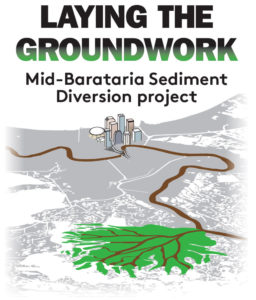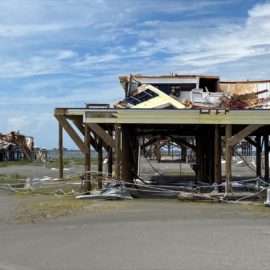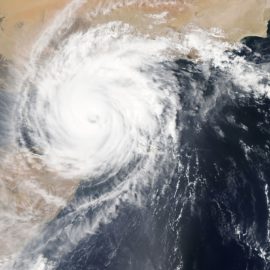
With an 8-0 vote, Plaquemines Parish Council voted against the Mid-Barataria Sediment Diversion as it will hurt the Parishes economy and culture.
In the strongest note of resistance to date, the Plaquemines Parish Council has decided to oppose Louisiana’s $2 billion plan to channel land-building sediment and nutrient-laden water from the Mississippi River through a new gated structure in the levee and into the Barataria Basin for coastal restoration. Members said the Mid-Barataria Sediment Diversion project would destroy their parish’s seafood-based economy and culture. The 8-0 thumbs down from the governing authority in the project’s home parish marks an expected rebuke for Gov. John Bel Edwards, his coastal planners and their nonprofit advocates, who see Mid-Barataria as the flagship project in the state’s 50-year, $50 billion effort to stave off the disappearance of much of the bottom third of Louisiana into the Gulf of Mexico. The project is designed to build 21 square miles of storm-buffering land in the Barataria Basin over 50 years, but Parish Council members said the Army Corps of Engineers’ draft environmental impact statement ignored what they consider a better and faster alternative: dredging sediment from the river and pumping it over the levee by pipeline to the basin’s open waters. They also said the project’s backers provided inadequate information about helping commercial and recreational fishers adapt to loss of their livelihoods and helping a half-dozen small communities on the West Bank of lower Plaquemines with what are predicted to be higher water levels.
nola.com
The vote occurred after a two hour discussion featuring both commercial interests and the state Coastal Protection and Restoration Authority.
“I brought this resolution forward because I didn’t think the people of Plaquemines Parish were being heard by the state and CPRA,” council Chairman Mark Cognevich said. Coastal authority Chairman Chip Kline urged council members to delay their vote until the Corps responds to public comments being submitted through May 4 and produces a final environmental study, which would be early next year. But in a last comment before the council voted, Kline made his own opinion clear: “I’m going to do everything I can to build this project because I believe it’s the only way to save this parish.” Cognevich said the conclusions of the state’s scientists who say the diversion will build land are not backed by his own view of the parish’s history. He pointed to the 1850 creation of three channels along the river – the Jump, Baptiste Collette and Cubits Gap – as equivalent to the Mid-Barataria plan to divert as much as 75,000 cubic feet per second of sediment, nutrients and water into the basin – and said none of the three has created significant amounts of new land. “Until I’m proven wrong through history, I’m not going with a guesstimate,” he said of the state’s estimate of new land. “I’m going to stand up and fight for the people in my district and parish. You want to kill a way of life.”
Councilman Stuart Guey argued that the motives of the state were to ask the question to enable the answer they wanted.
“It appears that the directive that was given was to figure out how to make a sediment diversion,” he said. “An excellent job was done.” Guey pointed to the corps report’s failure to include the dredge-and-pipeline marsh creation proposal among its seven alternatives.
Other councilmen raised other issues all noting that the study did not cover all the necessary topics raised. Acy Cooper, president of the Louisiana Shrimp Association said the offer to provide refrigeration to the shrimp boats was a bad one as the boats are not big enough to hold the equipment.
John Tesvich, a member of the state’s Oyster Task Force, said he felt used by the state government in his attendance at numerous meetings with state officials to discuss the diversion and its effects. “We are pawns,” he said. “They needed to check off on their list that they talked to the oyster industry, shrimp industry. They checked it off and ignored what we said.” Kline tried to respond to the numerous critics. “I come in peace,” Kline said during the first of his three returns to the podium. He said the Louisiana Trustees Implementation Group, which wrote a draft restoration plan outlining how the diversion would be built, has agreed to set aside $305 million for a variety of mitigation efforts, including programs that might elevate roads, homes, camps and docks for residents affected by rising water; others aimed at commercial and recreational fishing; and to address the diversion’s harmful effects on bottlenose dolphins. “This is real money that we will be required to expend on these initiatives,” Kline said.
Kline also noted that the preferred solution by the Parish was quickly discarded in the planning process as it only lasts 20 years while the diversion is designed for 50-100 years.
Choosing only the dredging alternative, Kline said, “is to look at our kids and say, yeah, 20 years. Enjoy the Barataria Basin while you can.” At the same time, he said, Louisiana’s Coastal Master Plan actually devotes most of its $25 billion of restoration money to build just those kinds of dredged-sediment projects, including several in the Barataria Basin. Kline said the diversion is better because it restores the Mississippi River’s natural land-building process, which ended when levees and jetties were built to contain the river. “With sediment diversions, there’s extensive land-building capability by diversion alone, but it’s also sustaining the land that is in place today and it sustains the land we’re going to be building through dredging,” he said.
The council vote came on the last day of the virtual town meetings being held on the diversion. over 60 people attended each of the three sessions but few spoke up – and most were concerned about high water in Myrtle Grove and nearby communities. Commercial fishers spoke about the demise of their industry. Four more sessions are set for the West Bank to discuss mitigation:
- Monday, 6:30 p.m. –Belle Chasse Middle School gymnasium, 13476 Louisiana 23, Belle Chasse; sponsored by Myrtle Grove Homeowners Association.
- Wednesday, 6 p.m. –Port Sulphur YMCA, 278 Civic Drive; sponsored by the Wood Park Community,
- Friday, noon –Port Sulphur YMCA, 278 Civic Drive, Port Sulphur, for Happy Jack residents.
- April 21, 6 p.m. –Lake Hermitage Volunteer Fire Department, 2766 Lake Hermitage Road. Port Sulphur, for Suzie Bayou and Deer Range residents.
The comments at these four meeting will not be on the public record but the attendees will be told how to submit official comments.



